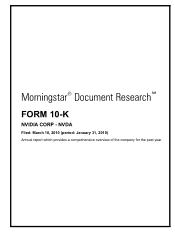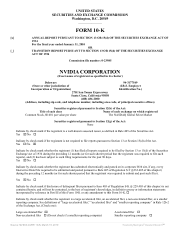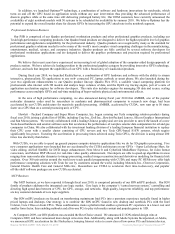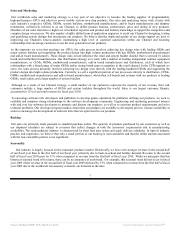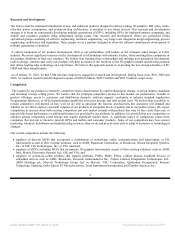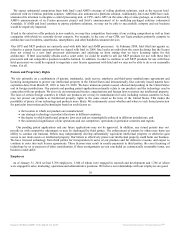NVIDIA 2010 Annual Report Download - page 6
Download and view the complete annual report
Please find page 6 of the 2010 NVIDIA annual report below. You can navigate through the pages in the report by either clicking on the pages listed below, or by using the keyword search tool below to find specific information within the annual report.
PART I
ITEM 1. BUSINESS
Forward-Looking Statements
This Annual Report on Form 10-K contains forward-looking statements within the meaning of Section 27A of the Securities Act of
1933, as amended, and Section 21E of the Securities Exchange Act of 1934, as amended, which are subject to the “safe harbor”
created by those sections. Forward-looking statements are based on our management’s beliefs and assumptions and on information
currently available to our management. In some cases, you can identify forward-looking statements by terms such as “may,” “will,”
“should,” “could,” “goal,” “would,” “expect,” “plan,” “anticipate,” “believe,” “estimate,” “project,” “predict,” “potential” and
similar expressions intended to identify forward-looking statements. These statements involve known and unknown risks, uncertainties
and other factors, which may cause our actual results, performance, time frames or achievements to be materially different from any
future results, performance, time frames or achievements expressed or implied by the forward-looking statements. We discuss many of
these risks, uncertainties and other factors in this Annual Report on Form 10-K in greater detail under the heading “Risk Factors.”
Given these risks, uncertainties and other factors, you should not place undue reliance on these forward-looking statements. Also,
these forward-looking statements represent our estimates and assumptions only as of the date of this filing. You should read this
Annual Report on Form 10-K completely and with the understanding that our actual future results may be materially different from
what we expect. We hereby qualify our forward-looking statements by these cautionary statements. Except as required by law, we
assume no obligation to update these forward-looking statements publicly, or to update the reasons actual results could differ
materially from those anticipated in these forward-looking statements, even if new information becomes available in the future.
All references to “NVIDIA,” “we,” “us,” “our” or the “Company” mean NVIDIA Corporation and its subsidiaries, except where
it is made clear that the term means only the parent company.
NVIDIA, GeForce, SLI, Hybrid SLI, GoForce, Quadro, NVIDIA Quadro, NVIDIA nForce, Tesla, Tegra, CUDA, NVIDIA APX, PhysX,
Ageia, Mental Images, and the NVIDIA logo are our trademarks and/or registered trademarks in the United States and other
countries that are used in this document. We may also refer to trademarks of other corporations and organizations in this document.
Our Company
NVIDIA Corporation helped awaken the world to the power of computer graphics when it invented the graphics processor unit, or
GPU, in 1999. Expertise in programmable GPUs has led to breakthroughs in parallel processing which make supercomputing
inexpensive and widely accessible. We serve the entertainment and consumer market with our GeForce graphics products, the
professional design and visualization market with our Quadro graphics products, the high-performance computing market with our
Tesla computing solutions products, and the mobile computing market with our Tegra system-on-a-chip products. During the last
several fiscal years, we have operated and reported four major product-line operating segments: the GPU business, the professional
solutions business, or PSB, the media and communications processor, or MCP, business, and the consumer products business, or CPB.
However, effective with the first quarter of fiscal year 2011, we will no longer separate our MCP and GPU operating segments as such
segmentation will no longer be reflective of the way we manage those businesses.
Our GPU business is comprised primarily of our GeForce products that support desktop and notebook personal computers, or PCs,
plus memory products. Our PSB is comprised of our Quadro professional workstation products and other professional graphics
products, including our NVIDIA Tesla high-performance computing products. Our MCP business, as we have reported it through
fiscal year 2010, has been comprised primarily of our ION motherboard GPUs, or mGPU products. Our CPB is comprised of our
Tegra mobile products that support tablets and smartbooks, smartphones, personal media players, or PMPs, internet television,
automotive navigation, and other similar devices. CPB also includes license, royalty, other revenue and associated costs related to
video game consoles and other digital consumer electronics devices. Original equipment manufacturers, or OEMs, original design
manufacturers, or ODMs, add-in-card manufacturers, system builders and consumer electronics companies worldwide utilize our
processors as a core component of their entertainment, business and professional solutions.
We were incorporated in California in April 1993 and reincorporated in Delaware in April 1998. Our headquarter facilities are in
Santa Clara, California. Our Internet address is www.nvidia.com. The contents of our website are not a part of this Form 10-K.
GPU Business
Our GPU business is comprised primarily of our GeForce products that support desktop and notebook PCs, plus memory products.
Our GPU business is focused on Microsoft Windows and Apple PC platforms. GeForce GPUs power PCs made by or distributed by
most PC OEMs in the world for desktop PCs, notebook PCs, and PCs loaded with Windows Media Center and other media extenders
such as the Apple TV. GPUs enhance the user experience for playing video games, editing photos, viewing and editing videos and
high-definition, or HD, movies.
We believe we are in an era where visual computing is becoming increasingly important to consumers and other end users of our
products. Our strategy is to promote our GeForce brand as one of the most important processors through technology leadership,
Source: NVIDIA CORP, 10-K, March 18, 2010 Powered by Morningstar® Document Research℠

